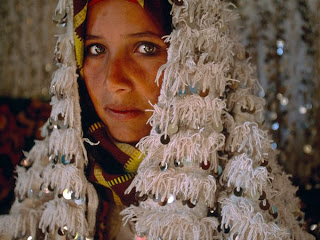Moroccan Bride
Photograph by Alexandra Boulat
A young Berber bride is adorned for pre-wedding festivities in the High Atlas mountains. Numbering some 25 million in North Africa and concentrated today in Morocco and Algeria, the Berbers (or Amazigh, as some prefer to be called) are an ethnically distinct tribal people who inhabited this area thousands of years before the Arab conquest brought Islam here in the seventh century A.D.
Erg Chebbi
Photograph by Simeone Huber/Getty Images
The sculpted sand peaks of Erg Chebbi mark the fringe of the Sahara and are a popular place for camel treks.
Menara Gardens
Photograph by Sergio Amiti, My Shot
Sundown at Menara Gardens provides a tranquil escape from sprawling Marrakech to the east. Designed in the 12th century as a summer escape from the city heat, the gardens' palms and olive trees rely on this artificial lake for irrigation.
Rif Mountains
Photograph by Travel Ink/Getty Images
Extending from Tangier to the Moulouya River Valley near the Moroccan-Algerian border, the Rif Mountains carve up 180 miles (290 kilometers) of rugged, remote terrain. The craggy mountain range travels along the Mediterranean Sea, sparing only a few coastal valleys for agricultural use or settlement.
Sahara
Photograph by Veronique Fleury, My Shot
Ouzoud Falls
Photograph by Panoramic Images/Getty Images
A popular tourist attraction in the province of Azilal in the High Atlas mountains, Ouzoud Falls gets it name from the surrounding olive, or ouzoud, trees.
Photograph by Scott E. Barbour/Getty Images
Twilight falls on the Place Mohammed V in the heart of Casablanca. The vast square is fronted by administrative buildings—including the Palais de Justice law courts building, at left, and the Ancienne Prefecture (Old Police Station) at right.
Jemaa el Fna Square, Marrakech
Photograph by Peter Phipp/Getty Images
At the center of Marrakech’s old quarter is the city's main square, usually filled with peddlers and entertainers of all kinds. Ringing Jemaa el Fna are the suq, cafes, and hotels and gardens.

Suq, Marrakech
Photograph by Atlantide Phototravel/Getty Images
Textiles, animal hides, and edibles fill Marrakech's suq, the largest in Morocco. The market stalls are filled with wares from Berber, Tuareg, and Dogon communities; what has not been imported from the desert is handcrafted in the city.








Aucun commentaire:
Enregistrer un commentaire